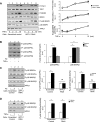APPL1 mediates adiponectin-stimulated p38 MAPK activation by scaffolding the TAK1-MKK3-p38 MAPK pathway
- PMID: 20978232
- PMCID: PMC3023211
- DOI: 10.1152/ajpendo.00427.2010
APPL1 mediates adiponectin-stimulated p38 MAPK activation by scaffolding the TAK1-MKK3-p38 MAPK pathway
Abstract
The adaptor protein APPL1 mediates the stimulatory effect of adiponectin on p38 mitogen-activated protein kinase (MAPK) signaling, yet the underlying mechanism remains unclear. Here we show that, in C(2)C(12) cells, overexpression or suppression of APPL1 enhanced or suppressed, respectively, adiponectin-stimulated p38 MAPK upstream kinase cascade, consisting of transforming growth factor-β-activated kinase 1 (TAK1) and mitogen-activated protein kinase kinase 3 (MKK3). In vitro affinity binding and coimmunoprecipitation experiments revealed that TAK1 and MKK3 bind to different regions of APPL1, suggesting that APPL1 functions as a scaffolding protein to facilitate adiponectin-stimulated p38 MAPK activation. Interestingly, suppressing APPL1 had no effect on TNFα-stimulated p38 MAPK phosphorylation in C(2)C(12) myotubes, indicating that the stimulatory effect of APPL1 on p38 MAPK activation is selective. Taken together, our study demonstrated that the TAK1-MKK3 cascade mediates adiponectin signaling and uncovers a scaffolding role of APPL1 in regulating the TAK1-MKK3-p38 MAPK pathway, specifically in response to adiponectin stimulation.
Figures





References
-
- Beltowski J, Jamroz-Wiśniewska A, Widomska S. Adiponectin and its role in cardiovascular diseases. Cardiovasc Hematol Disord Drug Targets 8: 7–46, 2008 - PubMed
-
- Choo MK, Sakurai H, Koizumi K, Saiki I. TAK1-mediated stress signaling pathways are essential for TNF-alpha-promoted pulmonary metastasis of murine colon cancer cells. Int J Cancer 118: 2758–2764, 2006 - PubMed
Publication types
MeSH terms
Substances
Grants and funding
LinkOut - more resources
Full Text Sources
Molecular Biology Databases
Miscellaneous

